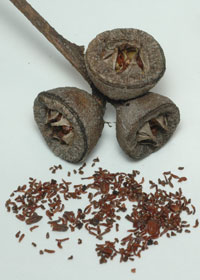The National Seed Bank
About Us | Collection & Curation | Testing & Re-testing of Seed | Research | Contact & Seed Supply
About Us
The National Seed Bank safeguards Australia’s flora by collecting seeds and storing them ex situ in our purpose-built facility, as well as by conducting research and supporting in situ plant conservation in the wild. Having seeds in the bank safeguards against the loss of genetic diversity and species extinction in the wild, and our research supports restoration, translocation, and land management efforts. Safeguarding biodiversity in insurance collections such as seed banks is a national and international conservation priority, as identified in the Global Strategy for Plant Conservation and the Australian Government's Threatened Species Action Plan 2022–32.
The National Seed Bank is located at the Australian National Botanic Gardens in the Australian Capital Territory. We specialise in collecting, storing and researching seeds from the ACT and surrounding region including grassland, grassy woodland, alpine and subalpine ecosystems, and from Australia's Commonwealth Parks including Kakadu National Park, Uluṟu-Kata Tjuṯa National Park, Christmas Island National Park, Pulu Keeling National Park, Booderee National Park, and Norfolk Island National Park and Botanic Gardens. The National Seed Bank holds seeds from approximately 4,000 different plant taxa, including many nationally listed threatened species. Collections have been made all over Australia and date back to the early 1960s.
The National Seed Bank acknowledges the value of different knowledge systems in tackling plant conservation and recognises that knowledge about plants and seeds is held in different ways, in different systems. In collaboration with First Nations people and its partners, the NSB will continue to make a significant contribution to plant conservation.
Collection and Curation
Seeds are collected from wild plant populations, and voucher specimens are housed and catalogued in the Australian National Herbarium.The National Seed Bank targets species that:
- are listed as threatened, or comprise part of a listed threatened ecological community, under the Environment Protection and Biodiversity Conservation Act 1999
- are of cultural or ecological significance
- support national conservation priorities, partnerships, research, and outreach activities
As seed collections come in, post-harvest data (e.g. storage conditions, cleaning methods, seed counts, etc.) are collected to maintain high quality conservation collections and generate knowledge about species' seed biology. The NSB has incorporated x-ray analysis and microscope imaging into its routine post-harvest workflow and anatomical images are captured for all species.
The curation and management of collections and their associated data are critical tasks necessary to achieve the best possible conservation outcomes from collecting efforts. The National Seed Bank undertakes curatorial work in line with contemporary best practice seed banking methods and international standards. Duplicate insurance collections are stored at other seed banks within Australia through the Australian Seed Bank Partnership, and at the Millennium Seed Bank (UK).
Testing and Re-testing of seed
Once a germplasm collection has been collected and curated, the next step is testing. This process involves assessing the viability and germinability of a seed collection through a range of tests and research trials. For each new collection coming into the seed bank, we aim to conduct initial testing of the seed while it's still fresh. The initial testing is where we investigate the best germination protocol for the species and establish a benchmark for the collection’s quality which can be used as a reference point for future re-testing and long-term monitoring of the collection.
In 2019, the National Seed Bank began a nation-first program to regularly re-test seed collections, providing invaluable insights into the longevity and viability of seed collections over time. Collections are re-tested at regular intervals and are compared to the benchmarks established in the initial testing process. This allows any changes in viability or germinability over time to be detected and assessed. Data gathered through this program then informs management practices and future collection targets, all whilst continuing to expand the understanding of germination requirements and seed biology, particularly for less-studied species.
Without adequate knowledge of how to germinate a germplasm collection, the conservation value it holds is limited. The testing process provides critical knowledge and insights into a collection, its germination requirements, and the species ecology more broadly. In this way, testing transforms a seed collection from stored material into a meaningful conservation tool.
Research
Research is a primary focus for the NSB and is of particular importance in the face of biodiversity loss and climate change threats. The NSB research programme investigates four main themes:
- Improving collection, processing and storage of seeds and non-seed germplasm
- Uncovering germination strategies and developing methods to reliably germinate collections
- Investigating seed comparative longevity and real-time survival in storage
- Investigating seed and seedling response to environmental stress
Wherever possible, the NSB seeks to integrate in situ and ex situ research and provide end-to-end management recommendations.
The NSB’s research programme is enriched by its collaborative research partnerships, and the contributions of the tertiary students it supports.
Contact and seed supply
The National Seed Bank can be contacted at info@anbg.gov.au.
The National Seed Bank can supply seed for approved research (not for profit) projects at other botanic gardens, universities and similar institutions subject to submission of a satisfactory permit application. Seed cannot be supplied to private individuals.
Applications for seed of species listed as threatened under the Environment Protection and Biodiversity Conservation Act are assessed separately under an EPBC permit application.
![Director of National Parks [logo]](../../../images/dnp_90px.gif)





